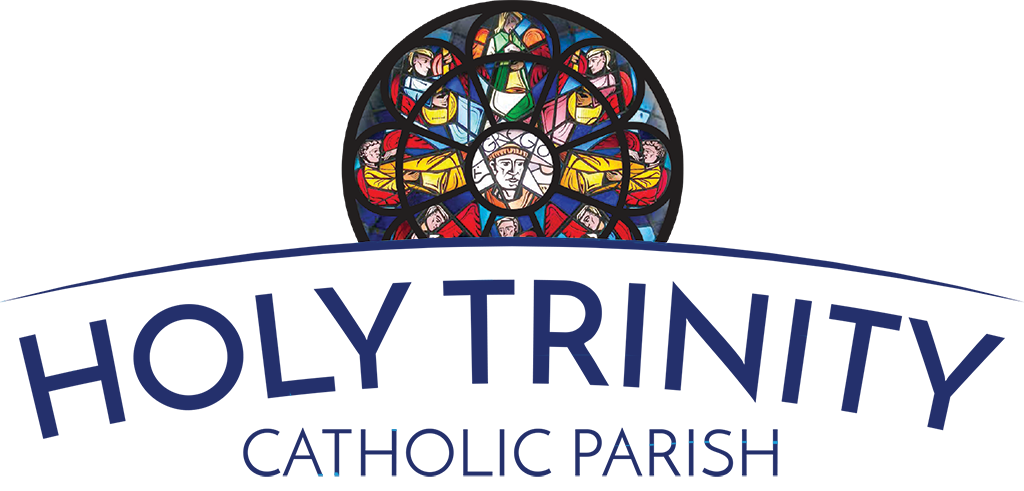Vigil: A Wake or Vigil may take place in the funeral home or in the church (provided it takes place well before the funeral liturgy). Its structure includes introductory rites, the liturgy of the Word, prayers of intercession, and a concluding rite. A priest, deacon or layperson may preside at this liturgy. The vigil service is the preferred time for family and friends to offer stories, reflections, and eulogies on the life of the deceased.
Funeral Mass is the central liturgical celebration for the deceased. The funeral Mass usually takes place at the parish church of the deceased. The Mass includes the reception of the body (if this has not already take place), the casket/coffin is sprinkled with holy water and the pall (white blanket) is placed upon it by family or friends of the deceased to recall the deceased’s baptism. Other Christian symbols, such as the Book of Gospels or a cross may be placed on top of the pall. The casket/coffin is then carried in procession toward the altar and placed near the paschal candle. Mass continues as the community celebrates the Liturgy of the Word, the homily is based on the readings and focuses on the paschal mystery and God’s love. The Liturgy of the Eucharist is celebrated as usual, followed by the prayer after Communion and then the final commendation (unless the commendation will be celebrated at the place of committal). At this time the deceased is entrusted to God’s tender care. The song of farewell is the climax of the rite of final commendation. This song, sung by the assembly, has a specific function: to affirm hope and trust in the paschal mystery. Incensing may take place during or following the song of farewell.
The commendation is the prayer in which “the community calls upon God’s mercy, commends the deceased into God’s hands, and affirms its belief that those who have died in Christ will share in Christ’s victory over death.”
Rite of Committal concludes the liturgical rites of a Catholic funeral; the burial of the deceased generally follows the rite of committal. The committal ordinarily takes place where the body of the deceased is to be buried (or “committed”) to the ground, or where the remains are to be interred. The committal is “the final act of the community of faith in caring for the body of its deceased member.” The rite includes the final commendation (unless the commendation has already been celebrated at the funeral Mass).
Is it permissible to have a funeral without a Mass? YES. While a funeral Mass is preferred, a funeral liturgy outside Mass is permitted. The rite may be used for various reasons: when the funeral Mass is not permitted, namely, on solemnities of obligation, on Holy Thursday and the Easter Triduum; when in some places or circumstances it is not possible to celebrate the funeral Mass before the committal (for example, if a priest is not available); when for pastoral reasons the parish priest (pastor) and the family decide that the funeral liturgy outside Mass is a more suitable form of celebration.
May a eulogy be given at a Catholic funeral? YES. The Church’s rites do allow a member or a friend of the family to speak in remembrance of the deceased prior to the final commendation. This is not a full eulogy, but a brief reflection (one person during Mass, duration: 5 minutes). If a family decides to deliver a eulogy during Mass or Funeral Liturgy outside of Mass, it ought to be communicated with the presider prior to beginning of the Liturgy. The vigil service is the preferred time for family and friends to offer stories, reflections, and eulogies on the life of the deceased.
The focus of a Christian funeral is the paschal mystery: the suffering, death, and resurrection of our Lord Jesus Christ. Because the focus is first on God, an optional eulogy does not play an essential part within the funeral liturgy. This does not mean we cannot reflect on and celebrate the life of the deceased. It does mean that such a celebration (sharing memories and stories about the loved one) of the life of the deceased would be more appropriate to a non-liturgical gathering (for example, a post-funeral luncheon).
May a casket be draped with an American flag for the Mass? NO. Any national flags or the flags or insignia of associations to which the deceased belonged are to be removed from the casket/coffin at the entrance of the church. They may be replaced after the casket/coffin has been taken from the church. Only Christian symbols may rest on or be placed near the casket/coffin during the funeral liturgy.
Cemetery: A Catholic Cemetery is a sacred place that is set aside by the local church’s bishop. It is not a requirement to be Catholic to be buried in a Catholic cemetery. Within the norms for Catholic burial, a Catholic may choose to be buried in a cemetery other than a Catholic one. The rite of committal includes a ritual for blessing the place of burial if it has not been previously blessed.
The information provided above is from the Rite of Christian Burial and the Federation of Diocesan Liturgical Commissions.

